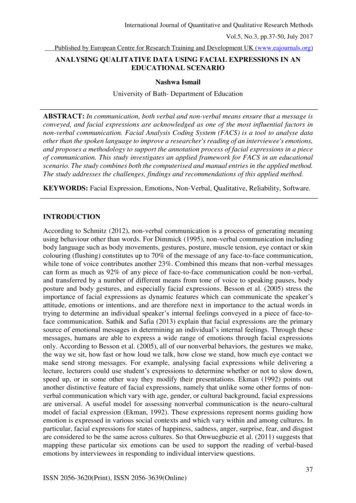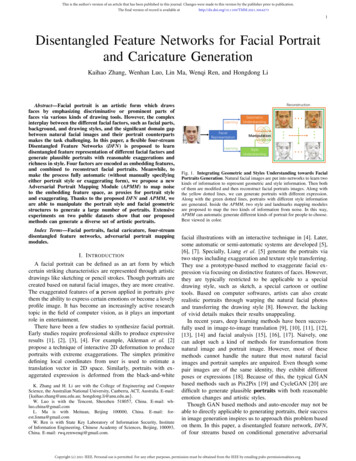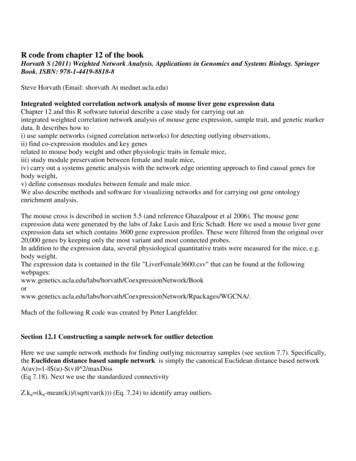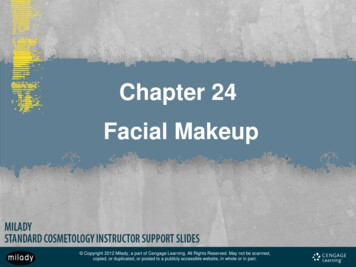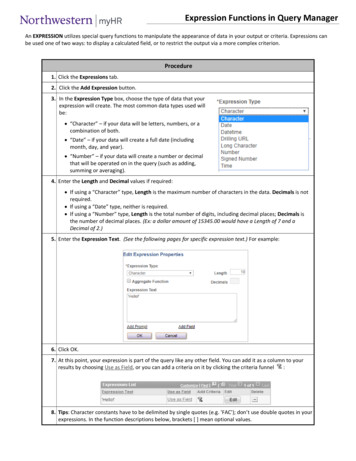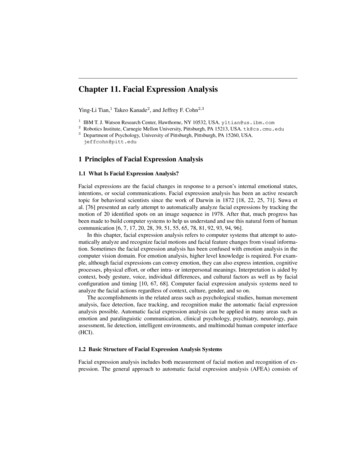
Transcription
Chapter 11. Facial Expression AnalysisYing-Li Tian,1 Takeo Kanade2 , and Jeffrey F. Cohn2,3123IBM T. J. Watson Research Center, Hawthorne, NY 10532, USA. yltian@us.ibm.comRobotics Institute, Carnegie Mellon University, Pittsburgh, PA 15213, USA. tk@cs.cmu.eduDepartment of Psychology, University of Pittsburgh, Pittsburgh, PA 15260, USA.jeffcohn@pitt.edu1 Principles of Facial Expression Analysis1.1 What Is Facial Expression Analysis?Facial expressions are the facial changes in response to a person’s internal emotional states,intentions, or social communications. Facial expression analysis has been an active researchtopic for behavioral scientists since the work of Darwin in 1872 [18, 22, 25, 71]. Suwa etal. [76] presented an early attempt to automatically analyze facial expressions by tracking themotion of 20 identified spots on an image sequence in 1978. After that, much progress hasbeen made to build computer systems to help us understand and use this natural form of humancommunication [6, 7, 17, 20, 28, 39, 51, 55, 65, 78, 81, 92, 93, 94, 96].In this chapter, facial expression analysis refers to computer systems that attempt to automatically analyze and recognize facial motions and facial feature changes from visual information. Sometimes the facial expression analysis has been confused with emotion analysis in thecomputer vision domain. For emotion analysis, higher level knowledge is required. For example, although facial expressions can convey emotion, they can also express intention, cognitiveprocesses, physical effort, or other intra- or interpersonal meanings. Interpretation is aided bycontext, body gesture, voice, individual differences, and cultural factors as well as by facialconfiguration and timing [10, 67, 68]. Computer facial expression analysis systems need toanalyze the facial actions regardless of context, culture, gender, and so on.The accomplishments in the related areas such as psychological studies, human movementanalysis, face detection, face tracking, and recognition make the automatic facial expressionanalysis possible. Automatic facial expression analysis can be applied in many areas such asemotion and paralinguistic communication, clinical psychology, psychiatry, neurology, painassessment, lie detection, intelligent environments, and multimodal human computer interface(HCI).1.2 Basic Structure of Facial Expression Analysis SystemsFacial expression analysis includes both measurement of facial motion and recognition of expression. The general approach to automatic facial expression analysis (AFEA) consists of
2Ying-Li Tian, Takeo Kanade, and Jeffrey F. Cohnthree steps (Fig. 11.1): face acquisition, facial data extraction and representation, and facialexpression recognition.Fig. 11.1. Basic structure of facial expression analysis systems.Face acquisition is a processing stage to automatically find the face region for the inputimages or sequences. It can be a detector to detect face for each frame or just detect face inthe first frame and then track the face in the remainder of the video sequence. To handle largehead motion, the the head finder, head tracking, and pose estimation can be applied to a facialexpression analysis system.After the face is located, the next step is to extract and represent the facial changes causedby facial expressions. In facial feature extraction for expression analysis, there are mainly twotypes of approaches: geometric feature-based methods and appearance-based methods. The geometric facial features present the shape and locations of facial components (including mouth,eyes, brows, and nose). The facial components or facial feature points are extracted to forma feature vector that represents the face geometry. With appearance-based methods, image filters, such as Gabor wavelets, are applied to either the whole-face or specific regions in a faceimage to extract a feature vector. Depending on the different facial feature extraction methods, the effects of in-plane head rotation and different scales of the faces can be eliminated byface normalization before the feature extraction or by feature representation before the step ofexpression recognition.Facial expression recognition is the last stage of AFEA systems. The facial changes canbe identified as facial action units or prototypic emotional expressions (see Section 2.1 fordefinitions). Depending on if the temporal information is used, in this chapter we classified therecognition approaches as frame-based or sequence-based.1.3 Organization of the ChapterThis chapter introduces recent advances in facial expression analysis. The first part discussesgeneral structure of AFEA systems. The second part describes the problem space for facialexpression analysis. This space includes multiple dimensions: level of description, individualdifferences in subjects, transitions among expressions, intensity of facial expression, deliberateversus spontaneous expression, head orientation and scene complexity, image acquisition andresolution, reliability of ground truth, databases, and the relation to other facial behaviors or
Chapter 11. Facial Expression Analysis3nonfacial behaviors. We note that most work to date has been confined to a relatively restrictedregion of this space. The last part of this chapter is devoted to a description of more specificapproaches and the techniques used in recent advances. They include the techniques for faceacquisition, facial data extraction and representation, and facial expression recognition. Thechapter concludes with a discussion assessing the current status, future possibilities, and openquestions about automatic facial expression analysis.Fig. 11.2. Emotion-specified facial expression (posed images from database [43] ). 1, disgust; 2,fear; 3, joy; 4, surprise; 5, sadness; 6, anger. From Schmidt and Cohn [72], with permission.2 Problem Space for Facial Expression Analysis2.1 Level of DescriptionWith few exceptions [17, 20, 30, 81], most AFEA systems attempt to recognize a small setof prototypic emotional expressions as shown in Fig. 11.2, (i.e., disgust, fear, joy, surprise,sadness, anger). This practice may follow from the work of Darwin [18] and more recentlyEkman and Friesen [23, 24] and Izard et al. [42] who proposed that emotion-specified expressions have corresponding prototypic facial expressions. In everyday life, however, such prototypic expressions occur relatively infrequently. Instead, emotion more often is communicatedby subtle changes in one or a few discrete facial features, such as tightening of the lips in angeror obliquely lowering the lip corners in sadness [11]. Change in isolated features, especially inthe area of the eyebrows or eyelids, is typical of paralinguistic displays; for instance, raisingthe brows signals greeting [21]. To capture such subtlety of human emotion and paralinguisticcommunication, automated recognition of fine-grained changes in facial expression is needed.The facial action coding system (FACS: [25]) is a human-observer-based system designed todetect subtle changes in facial features. Viewing videotaped facial behavior in slow motion,trained observers can manually FACS code all possible facial displays, which are referred to asaction units and may occur individually or in combinations.FACS consists of 44 action units. Thirty are anatomically related to contraction of a specificset of facial muscles (Table 11.1) [22]. The anatomic basis of the remaining 14 is unspecified(Table 11.2). These 14 are referred to in FACS as miscellaneous actions. Many action unitsmay be coded as symmetrical or asymmetrical. For action units that vary in intensity, a 5point ordinal scale is used to measure the degree of muscle contraction. Table 11.3 shows someexamples of combinations of FACS action units.Although Ekman and Friesen proposed that specific combinations of FACS action units represent prototypic expressions of emotion, emotion-specified expressions are not part of FACS;they are coded in separate systems, such as the emotional facial action system (EMFACS) [37].
4Ying-Li Tian, Takeo Kanade, and Jeffrey F. CohnTable 11.1. FACS action units (AU). AUs with ”*” indicate that the criteria have changed for thisAU, that is, AU 25, 26, and 27 are now coded according to criteria of intensity (25A-E), and AU41, 42, and 43 are now coded according to criteria of intensity.AU 1AU 2Inner BrowRaiser*AU 41Outer BrowRaiser*AU 42LidDroopSlitAU 9AU 10NoseWrinklerAU 15Upper Face Action UnitsAU 4AU 5AU 6AU 7Upper LidRaiserAU 44CheekRaiserAU 45LidTightenerAU 46EyesSquintClosedLower Face Action UnitsAU 11AU 12BlinkWinkAU 13AU 14Upper LipRaiserAU 16NasolabialDeepenerAU 17Lip CornerPullerAU 18CheekPufferAU 20DimplerLip CornerDepressorAU 23Lower LipDepressorAU 24ChinRaiser*AU 25LipPuckerer*AU 26LipStretcher*AU 27LipFunnelerAU hLipSuckBrowLowerer*AU 43AU 22FACS itself is purely descriptive and includes no inferential labels. By converting FACS codesto EMFACS or similar systems, face images may be coded for emotion-specified expressions(e.g., joy or anger) as well as for more molar categories of positive or negative emotion [56].2.2 Individual Differences in SubjectsFace shape, texture, color, and facial and scalp hair vary with sex, ethnic background, and age[29, 99]. Infants, for instance, have smoother, less textured skin and often lack facial hair in thebrows or scalp. The eye opening and contrast between iris and sclera differ markedly betweenAsians and Northern Europeans, which may affect the robustness of eye tracking and facialfeature analysis more generally. Beards, eyeglasses, or jewelry may obscure facial features.Such individual differences in appearance may have important consequences for face analysis.Few attempts to study their influence exist. An exception was a study by Zlochower et al. [99],who found that algorithms for optical flow and high-gradient component detection that hadbeen optimized for young adults performed less well when used in infants. The reduced texture
Chapter 11. Facial Expression Analysis5Table 11.2. Miscellaneous ps towardTongue showNeck tightenJaw thrustJaw sidewaysJaw clenchBite lipBlowPuffCheek suckTongue bulgeLip wipeNostril dilateNostril compressTable 11.3. Some examples of combination of FACS action units.AU 1 2AU 1 4AU 4 5AU 1 2 4AU 1 2 5AU 1 6AU 6 7AU 1 2 5 6 7AU 23 24AU 9 17AU 9 25AU 9 17 23 24AU 10 17AU 10 25AU 10 15 17AU 12 25AU 12 26AU 15 17AU 17 23 24AU 20 25of infants’ skin, their increased fatty tissue, juvenile facial conformation, and lack of transientfurrows may all have contributed to the differences observed in face analysis between infantsand adults.In addition to individual differences in appearance, there are individual differences in expressiveness, which refers to the degree of facial plasticity, morphology, frequency of intenseexpression, and overall rate of expression. Individual differences in these characteristics arewell established and are an important aspect of individual identity [53] (these individual differences in expressiveness and in biases for particular facial actions are sufficiently strong thatthey may be used as a biometric to augment the accuracy of face recognition algorithms [16]).An extreme example of variability in expressiveness occurs in individuals who have incurreddamage either to the facial nerve or central nervous system [63, 85]. To develop algorithmsthat are robust to individual differences in facial features and behavior, it is essential to include
6Ying-Li Tian, Takeo Kanade, and Jeffrey F. Cohna large sample of varying ethnic background, age, and sex, which includes people who havefacial hair and wear jewelry or eyeglasses and both normal and clinically impaired individuals.2.3 Transitions Among ExpressionsA simplifying assumption in facial expression analysis is that expressions are singular and begin and end with a neutral position. In reality, facial expression is more complex, especially atthe level of action units. Action units may occur in combinations or show serial dependence.Transitions from action units or combination of actions to another may involve no interveningneutral state. Parsing the stream of behavior is an essential requirement of a robust facial analysis system, and training data are needed that include dynamic combinations of action units,which may be either additive or nonadditive.As shown in Table 11.3, an example of an additive combination is smiling (AU 12) withmouth open, which would be coded as AU 12 25, AU 12 26, or AU 12 27 depending on thedegree of lip parting and whether and how far the mandible was lowered. In the case of AU12 27, for instance, the facial analysis system would need to detect transitions among all threelevels of mouth opening while continuing to recognize AU 12, which may be simultaneouslychanging in intensity.Nonadditive combinations represent further complexity. Following usage in speech science,we refer to these interactions as co-articulation effects. An example is the combination AU12 15, which often occurs during embarrassment. Although AU 12 raises the cheeks and lipcorners, its action on the lip corners is modified by the downward action of AU 15. The resultingappearance change is highly dependent on timing. The downward action of the lip corners mayoccur simultaneously or sequentially. The latter appears to be more common [73]. To be comprehensive, a database should include individual action units and both additive and nonadditivecombinations, especially those that involve co-articulation effects. A classifier trained only onsingle action units may perform poorly for combinations in which co-articulation effects occur.2.4 Intensity of Facial ExpressionFacial actions can vary in intensity. Manual FACS coding, for instance, uses a 3- or more recently a 5-point intensity scale to describe intensity variation of action units (for psychometricdata, see Sayette et al. [70]). Some related action units, moreover, function as sets to representintensity variation. In the eye region, action units 41, 42, and 43 or 45 can represent intensityvariation from slightly drooped to closed eyes. Several computer vision researchers proposedmethods to represent intensity variation automatically. Essa and Pentland [28] represented intensity variation in smiling using optical flow. Kimura and Yachida [44] and Lien et al. [50]quantified intensity variation in emotion-specified expression and in action units, respectively.These authors did not, however, attempt the more challenging step of discriminating intensityvariation within types of facial actions. Instead, they used intensity measures for the more limited purpose of discriminating between different types of facial actions. Bartlett and colleagues[4] tested their algorithms on facial expressions that systematically varied in intensity as measured by manual FACS coding. Although they failed to report results separately for each level ofintensity variation, their overall findings suggest some success. Tian et al. [83] may be the onlygroup to compare manual and automatic coding of intensity variation. Using Gabor features
Chapter 11. Facial Expression Analysis7and an artificial neural network, they discriminated intensity variation in eye closure as reliablyas did human coders. These findings suggest that it is feasible to automatically recognize intensity variation within types of facial actions. Regardless of whether investigators attempt todiscriminate intensity variation within facial actions, it is important that the range of variationbe described adequately. Methods that work for intense expressions may generalize poorly toones of low intensity.2.5 Deliberate Versus Spontaneous ExpressionMost face expression data have been collected by asking subjects to perform a series of expressions. These directed facial action tasks may differ in appearance and timing from spontaneously occurring behavior [27]. Deliberate and spontaneous facial behavior are mediated byseparate motor pathways, the pyramidal and extrapyramidal motor tracks, respectively [63]. Asa consequence, fine-motor control of deliberate facial actions is often inferior and less symmetrical than what occurs spontaneously. Many people, for instance, are able to raise their outerbrows spontaneously while leaving their inner brows at rest; few can perform this action voluntarily. Spontaneous depression of the lip corners (AU 15) and raising and narrowing the innercorners of the brow (AU 1 4) are common signs of sadness. Without training, few people canperform these actions deliberately, which incidentally is an aid to lie detection [27]. Differencesin the temporal organization of spontaneous and deliberate facial actions are particularly important in that many pattern recognition approaches, such as hidden Markov modelling, are highlydependent on the timing of the appearance change. Unless a database includes both deliberateand spontaneous facial actions, it will likely prove inadequate for developing face expressionmethods that are robust to these differences.2.6 Head Orientation and Scene ComplexityFace orientation relative to the camera, the presence and actions of other people, and background conditions may influence face analysis. In the face recognition literature, face orientation has received deliberate attention. The FERET database [64], for instance, includes bothfrontal and oblique views, and several specialized databases have been collected to try to develop methods of face recognition that are invariant to moderate change in face orientation [86].In the face expression literature, use of multiple perspectives is rare; and relatively less attentionhas been focused on the problem of pose invariance. Most researchers assume that face orientation is limited to in-plane variation [4] or that out-of-plane rotation is small [51, 58, 65, 81]. Inreality, large out-of-plane rotation in head position is common and often accompanies changein expression. Kraut and Johnson [48] found that smiling typically occurs while turning towardanother person. Camras et al. [9] showed that infant surprise expressions often occur as theinfant pitches her head back. To develop pose invariant methods of face expression analysis,image data are needed in which facial expression changes in combination with significant nonplanar change in pose. Some efforts have been made to handle large out-of-plane rotation inhead position [80, 90, 91].Scene complexity, such as background and the presence of other people, potentially influences accuracy of face detection, feature tracking, and expression recognition. Most databasesuse image data in which the background is neutral or has a consistent pattern and only a single
8Ying-Li Tian, Takeo Kanade, and Jeffrey F. Cohnperson is present in the scene. In natural environments, multiple people interacting with eachother are likely, and their effects need to be understood. Unless this variation is represented intraining data, it will be difficult to develop and test algorithms that are robust to such variation.2.7 Image Acquisition and ResolutionThe image acquisition procedure includes several issues, such as the properties and numberof video cameras and digitizer, the size of the face image relative to total image dimensions,and the ambient lighting. All of these factors may influence facial expression analysis. Images acquired in low light or at coarse resolution can provide less information about facialfeatures. Similarly, when the face image size is small relative to the total image size, less information is available. NTSC cameras record images at 30 frames per second, The implications ofdown-sampling from this rate are unknown. Many algorithms for optical flow assume that pixeldisplacement between adjacent frames is small. Unless they are tested at a range of samplingrates, the robustness to sampling rate and resolution cannot be assessed.Within an image sequence, changes in head position relative to the light source and variationin ambient lighting have potentially significant effects on face expression analysis. A lightsource above the subject’s head causes shadows to fall below the brows, which can obscurethe eyes, especially for subjects with pronounced bone structure or hair. Methods that workwell in studio lighting may perform poorly in more natural lighting (e.g., through an exteriorwindow) when the angle of lighting changes across an image sequence. Most investigatorsuse single-camera setups, which is problematic when a frontal orientation is not required. Withimage data from a single camera, out-of-plane rotation may be difficult to standardize. For largeout-of-plane rotation, multiple cameras may be required. Multiple camera setups can supportthree dimensional (3D) modelling and in some cases ground truth with which to assess theaccuracy of image alignment. Pantic and Rothkrantz [60] were the first to use two camerasmounted on a headphone-like device; one camera is placed in front of the face and the other onthe right side of the face. The cameras are moving together with the head to eliminate the scaleand orientation variance of the acquired face images.Table 11.4. A face at different resolutions. All images are enlarged to the same size. At 48 x 64pixels the facial features such as the corners of the eyes and the mouth become hard to detect.Facial expressions are not recognized at 24 x 32 pixels [80].FaceProcess96 x essions?Yes69 x 93YesYesYesYesYes48 x 64YesYesYesMaybeMaybe24 x 32YesYesMaybeNoNo
Chapter 11. Facial Expression Analysis9Image resolution is another concern. Professional grade PAL cameras, for instance, providevery high resolution images. By contrast, security cameras provide images that are seriouslydegraded. Although postprocessing may improve image resolution, the degree of potential improvement is likely limited. Also the effects of post processing for expression recognition arenot known. Table 11.4 shows a face at different resolutions. Most automated face processingtasks should be possible for a 69 x 93 pixel image. At 48 x 64 pixels the facial features suchas the corners of the eyes and the mouth become hard to detect. The facial expressions may berecognized at 48 x 64 and are not recognized at 24 x 32 pixels. Algorithms that work well atoptimal resolutions of full face frontal images and studio lighting can be expected to performpoorly when recording conditions are degraded or images are compressed. Without knowing theboundary conditions of face expression algorithms, comparative performance is difficult to assess. Algorithms that appear superior within one set of boundary conditions may perform morepoorly across the range of potential applications. Appropriate data with which these factors canbe tested are needed.2.8 Reliability of Ground TruthWhen training a system to recognize facial expression, the investigator assumes that trainingand test data are accurately labeled. This assumption may or may not be accurate. Askingsubjects to perform a given action is no guarantee that they will. To ensure internal validity,expression data must be manually coded, and the reliability of the coding verified. Interobserver reliability can be improved by providing rigorous training to observers and monitoringtheir performance. FACS coders must pass a standardized test, which ensures (initially) uniform coding among international laboratories. Monitoring is best achieved by having observersindependently code a portion of the same data. As a general rule, 15% to 20% of data shouldbe comparison-coded. To guard against drift in coding criteria [54], re-standardization is important. When assessing reliability, coefficient kappa [32] is preferable to raw percentage ofagreement, which may be inflated by the marginal frequencies of codes. Kappa quantifies interobserver agreement after correcting for the level of agreement expected by chance.2.9 DatabasesBecause most investigators have used relatively limited data sets, the generalizability of different approaches to facial expression analysis remains unknown. In most data sets, only relativelyglobal facial expressions (e.g., joy or anger) have been considered, subjects have been few innumber and homogeneous with respect to age and ethnic background, and recording conditionshave been optimized. Approaches to facial expression analysis that have been developed inthis way may transfer poorly to applications in which expressions, subjects, contexts, or imageproperties are more variable. In the absence of comparative tests on common data, the relative strengths and weaknesses of different approaches are difficult to determine. In the areas offace and speech recognition, comparative tests have proven valuable [64], and similar benefitswould likely accrue in the study of facial expression analysis. A large, representative test-bed isneeded with which to evaluate different approaches. We have built a common database (CohnKanade AU-Coded Face Expression Image Database) with which multiple laboratories mayconduct comparative tests of their methods [43]. The details of the Cohn-Kanade AU-CodedFace Expression Image Database can be found in Chapter 12.
10Ying-Li Tian, Takeo Kanade, and Jeffrey F. Cohn2.10 Relation to Other Facial Behavior or Nonfacial BehaviorFacial expression is one of several channels of nonverbal communication. Contraction of themuscle zygomaticus major (AU 12), for instance, often is associated with positive or happyvocalizations, and smiling tends to increase vocal fundamental frequency [15]. Also facial expressions often occur during conversations. Both expressions and conversations can cause facialchanges. Few research groups, however, have attempted to integrate gesture recognition broadlydefined across multiple channels of communication. An important question is whether there areadvantages to early rather than late integration [35]. Databases containing multimodal expressive behavior afford the opportunity for integrated approaches to analysis of facial expression,prosody, gesture, and kinetic expression.2.11 Summary and Ideal Facial Expression Analysis SystemsThe problem space for facial expression includes multiple dimensions. An ideal facial expression analysis system has to address all these dimensions, and it outputs accurate recognitionresults. In addition, the ideal facial expression analysis system must perform automatically andin real-time for all stages ( Fig. 11.1). So far, several systems can recognize expressions in realtime [47, 58, 80]. We summarize the properties of an ideal facial expression analysis system inTable 11.5.Table 11.5. Properties of an ideal facial expression analysis 3An1An2RobustnessDeal with subjects of different age, gender, ethnicityHandle lighting changesHandle large head motionHandle occlusionHandle different image resolutionRecognize all possible expressionsRecognize expressions with different intensityRecognize asymmetrical expressionsRecognize spontaneous expressionsAutomatic processAutomatic face acquisitionAutomatic facial feature extractionAutomatic expression recognitionReal-time processReal-time face acquisitionReal-time facial feature extractionReal-time expression recognitionAutonomic ProcessOutput recognition with confidenceAdaptive to different level outputs based on input images
Chapter 11. Facial Expression Analysis113 Recent Advances in Automatic Facial Expression AnalysisFor automatic facial expression analysis, Suwa et al. [76] presented an early attempt in 1978 toanalyze facial expressions by tracking the motion of 20 identified spots on an image sequence.Considerable progress had been made since 1990 in related technologies such as image analysisand pattern recognition that make AFEA possible. Samal and Iyengar [69] surveyed the earlywork (before 1990) about automatic recognition and analysis of human face and facial expression. Recently, two survey papers summarized the work (before year 1999) of facial expressionanalysis [31, 59]. In this chapter, instead of giving a comprehensive survey of facial expressionanalysis literature, we explore the recent advances in facial expression analysis based on threeproblems: (1) face acquisition, (2) facial feature extraction and representation, and (3) facialexpression recognition.The most extensive work about facial expression analysis includes the systems of CMU(Carnegie Mellon University) [81, 82, 14, 57, 90] , UCSD (University of California, San Diego)[3, 20, 33], UIUC (University of Illinois at Urbana-Champaign) [13, 88], MIT (MassachusettsInstitute of Technology) [28], UMD (University of Maryland) [7, 93], TUDELFT (Delft University of Technology) [60, 59], IDIAP (Dalle Molle Institute for Perceptual Artificial Intelligence)[30, 31], and others [52, 97]. Because most of the work of MIT, UMD, TUDELFT, IDIAP, andothers are summarized in the survey papers [31, 59], here we summarize the systems of CMU,UCSD, and UIUC. We focus on the new developments after year 2000. The recent research inautomatic facial expression analysis tends to follow these directions: Build more robust systems for face acquisition, facial data extraction and representation,and facial expression recognition to handle head motion (in-plane and out-of-plane), occlusion, lighting changes, and lower intensity of expressionsEmploy more facial features to recognize more expressions and to achieve a higher recognition rateRecognize facial action units and their combinations rather than emotion-specified expressionsRecognize action units as they occur spontaneouslyDevelop fully automatic and real-time AFEA systemsTable 11.6 summarizes the basic properties of the systems from the above three universities.Altogether, six systems are compared. They ar
head motion, the the head finder, head tracking, and pose estimation can be applied to a facial expression analysis system. After the face is located, the next step is to extract and represent the facial changes caused by facial expressions. In facial feature extraction for e

